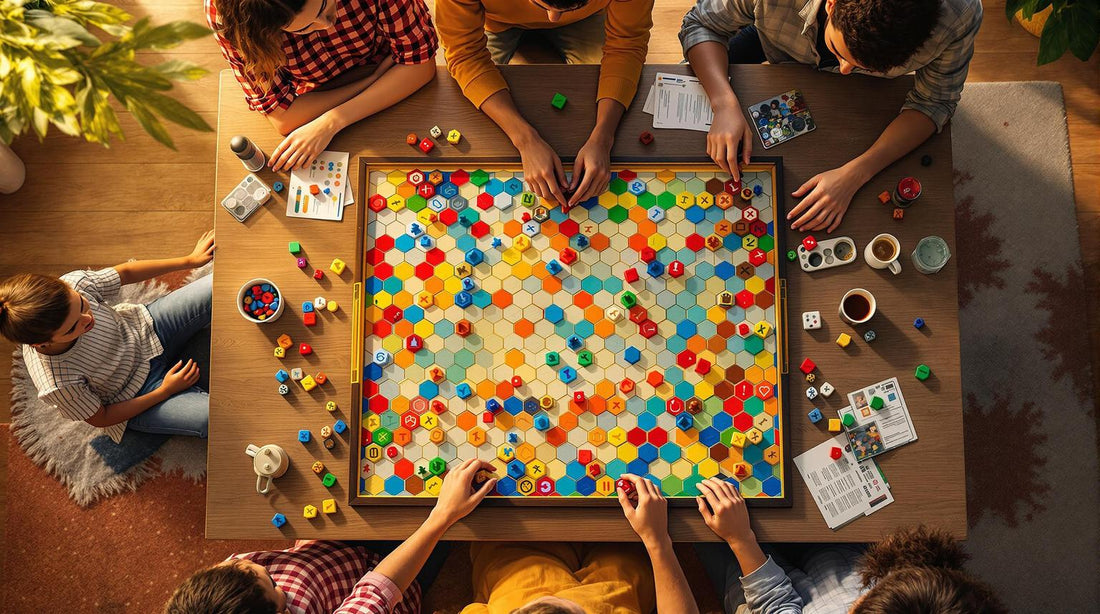Discover the Best Board Games for Every Player

How Player Count Impacts Game Design
The number of players in a game determines how it’s designed. Whether for 1, 2, or 4+ players, the mechanics, strategies, and interactions change significantly. Here’s what you need to know:
- Small Groups (1-2 Players): Focus on puzzles, direct competition, and balanced strategies. Examples: Chess, Railroad Ink.
- Large Groups (4+ Players): Emphasize social interaction, shared goals, and keeping everyone engaged. Examples: Werewolf, 7 Wonders.
- Key Differences: Small groups prioritize tight mechanics and quick gameplay, while large groups need scalable systems and minimal downtime.
Quick Comparison
| Feature | Small Groups (1-2 Players) | Large Groups (4+ Players) |
|---|---|---|
| Player Interaction | Direct competition | Social dynamics, alliances |
| Turn Structure | Sequential turns | Simultaneous or streamlined turns |
| Game Length | Shorter sessions | Longer, more dynamic sessions |
| Resource Management | Tight control | Shared or traded among players |
Game design must adapt to player count to ensure fairness, engagement, and fun. Let’s explore how these principles shape games for different group sizes.
Board Games that are GREAT at all player counts
1. Small Group Games (1-2 Players)
Small group games bring unique challenges that influence mechanics and strategy, showing how player count directly impacts game design.
Solo Gaming Experience
Solo games often focus on solving puzzles or overcoming preset challenges. For example, Logic Cards: Blue challenges players to rely solely on their problem-solving skills, without incorporating social interactions.
Two-Player Dynamics
Games like Chess and Checkers highlight key elements of two-player designs:
- Direct competition between players
- Turn-based strategies
- Equal opportunities for both players
- Instant feedback on decisions
These elements create engaging experiences, even in small settings.
Scalable Game Design
Some games work equally well with small groups. For instance, Railroad Ink offers a rewarding experience for two players by maintaining its focus on logic and planning, regardless of the number of participants.
Design Considerations
| Aspect | Solo Games | Two-Player Games |
|---|---|---|
| Primary Focus | Individual problem-solving | Strategy and balance between players |
| Engagement Method | Achievement-based goals | Direct player interaction |
| Outcome Measures | Personal high scores, completion | Competitive results |
| Replayability Factors | Adjustable difficulty levels | Adapting to different opponents |
Games like Kluster successfully combine solo and competitive elements, proving that well-thought-out small group designs can be just as engaging and balanced as those for larger groups.
sbb-itb-1ed942f
2. Large Group Games (4+ Players)
Unlike small group games that focus on tighter competition, games for larger groups need to keep everyone engaged while handling more complex interactions. The shift from small to large groups changes the way games flow and how players interact, requiring thoughtful adjustments to both social and gameplay mechanics.
Social Interaction Mechanics
Large group games often emphasize player interaction in creative ways. For example, Werewolf thrives on social deduction, where players must work together, negotiate, and figure out each other's roles. These dynamics naturally lead to alliances, discussions, and group decisions that drive the game forward.
But keeping everyone involved also means managing turns effectively.
Turn Management
Managing turns in larger groups is key to avoiding long waits and keeping players engaged. Here are some common mechanics:
| Mechanic | Purpose | Example |
|---|---|---|
| Simultaneous Actions | Cuts down on waiting time | Players choose cards at the same time in 7 Wonders |
| Split-Phase Turns | Keeps everyone active | All players collect resources together in one phase |
| Dynamic Player Roles | Ensures involvement during others' turns | Players perform specific actions while others play |
| Parallel Play | Allows players to act at the same time | Individual boards let players make decisions concurrently |
Scaling Complexity
Games like Pandemic handle larger groups effectively by introducing smart adjustments:
- Resource Distribution: Sharing game components across more players.
- Role Specialization: Assigning each player unique abilities to contribute.
- Shared Objectives: Encouraging teamwork through common goals.
These strategies help keep the game balanced and engaging for everyone.
Design Considerations for Large Groups
When designing for larger groups, it’s important to focus on:
- Component Availability: Making sure there are enough pieces for everyone.
- Visible Information: Keeping the game state clear and accessible to all players.
- Player Engagement: Minimizing downtime to maintain interest.
- Simple Rules: Ensuring mechanics are easy to understand and scale well.
Games like Dixit are great examples of how to handle large groups. They use these principles to deliver smooth gameplay while keeping everyone involved and entertained.
Comparing Player Count Effects
The number of players in a game directly influences its mechanics and player interactions. Here's a breakdown of how player count affects key design elements and gameplay dynamics.
Core Design Elements Comparison
| Design Element | Small Group (1–2 Players) | Large Group (4+ Players) |
|---|---|---|
| Player Interaction | Focused competition with direct strategies | Social dynamics like negotiation and alliances |
| Turn Structure | Sequential turns to keep players engaged | Often uses simultaneous or streamlined turns |
| Resource Management | Tight control with limited sharing | Resources shared or traded among players |
| Game Duration | Shorter, more focused sessions | Longer sessions to accommodate more players |
| Component Requirements | Fewer pieces with a simple design | More pieces to support complex interactions |
These differences highlight unique challenges when scaling games for different group sizes.
Scaling Challenges
- Balancing Mechanics: Small groups need precise, tightly tuned mechanics. Larger groups require flexible systems for resource distribution to avoid imbalances.
- Engagement: In larger groups, reducing downtime between turns is key to keeping players involved.
Design Solutions for Scaling
- Modular Components: Configurable boards or play areas ensure optimal spacing and interaction, no matter the group size.
- Variable Setup Rules: Adjusting setup rules helps maintain balance across different player counts.
- Dynamic Systems: Trading or voting systems that scale naturally with the number of players encourage engagement and deeper interaction.
Impact on Strategy
Smaller groups allow for immediate cause-and-effect decision-making, where every move feels impactful. Larger groups, on the other hand, introduce more variables, requiring players to adapt their strategies to a more dynamic environment.
At Brain Games (https://brain-games.com), we apply these principles to create games that deliver a smooth and enjoyable experience, whether you're playing with a couple of friends or a full group. These strategies ensure our games remain engaging for all player counts.
Conclusion
This analysis highlighted how the number of players can influence game mechanics and interactions. Recognizing these dynamics is crucial when designing board games that work well for different group sizes. Adjusting game design to fit specific player counts ensures smoother mechanics and encourages enjoyable social interactions.
At Brain Games, we focus on creating games that perform well regardless of the group size. Our goal is to offer titles with balanced mechanics, strong player engagement, and effective resource management, making them fun and adaptable for everyone.






